Hubert von Herkomer
Sir Hubert von Herkomer CVO RA (born as Hubert Herkomer; 26 May 1849 – 31 March 1914) was a Bavarian-born British painter, pioneering film-director, and composer. Though a very successful portrait artist, especially of men, he is mainly remembered for his earlier works that took a realistic approach to the conditions of life of the poor. Hard Times (1885; Manchester Art Gallery) showing the distraught family of a travelling day-labourer at the side of a road, is one of his best-known works.
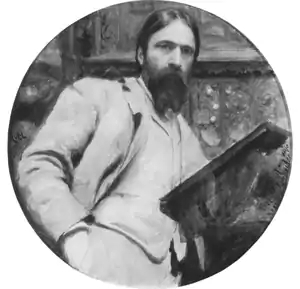
Early life and education
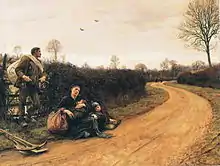
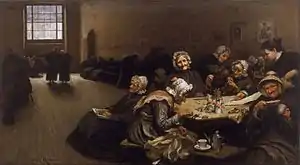
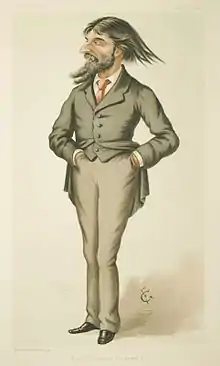
Herkomer as caricatured by FG (Franz Goedecker) in Vanity Fair, Jan. 26, 1884
Herkomer was born on 26 May 1849 at Waal, in the Kingdom of Bavaria, the son of Lorenz Herkomer, a wood-carver of great ability, and his wife Josephine Niggl. His family was poor, and his mother tried to supplement his father’s earnings by giving music lessons. Once his mother gave him a half sovereign for some shopping: "It was the last piece of gold in the place. I lost it. My parents were in despair".[1]
Lorenz Herkomer left Bavaria in 1851 with his wife and child for the United States, settling in Cleveland, Ohio. They soon returned to Europe and in 1857 settled in Southampton at 10, Windsor Terrace, where the family spent seventeen years before moving to a house called Dyreham in Bushey in 1874. Hubert's education was slight: "He went to school for a month or two, and, falling ill never returned".[1]
In a lengthy interview for the boys' annual Chums in 1896, Herkomer recalled his childhood: "We had an anxious time of it when I was a boy. We were constantly in want of money..... I was always inclined to art, and as a little boy worked principally at my father's bench, but by the time I had turned twelve I had produced quite a number of water-colour drawings. The reputation I gained among my play fellows, however, was as a maker of kites". He also crafted mechanical toys including clowns and wagons to give to his friends.[1]
While in Southampton, Herkomer went to the school of art there and began his formal art training. An uncle in the United States of American commissioned his father to carve the four evangelists in wood. Receiving some money, his father determined to take Hubert to Munich, so that he could study art there while his father worked on the carving. In Chums, he recalled his trip vividly: "Ah, how I remember that first visit to Germany! ... We crossed to Antwerp in a cattle boat ... And never shall I forget the miseries of that voyage. And then there were the railway carriages on the other side. We were compelled to travel fourth-class, in the company of people who were no less filthy than the carriages; and I remember..... I swore a big oath that if ever I had any money I would travel in the most luxurious style possible. I have never forgotten that oath". The pair led a hard life whilst in Munich, but he stated that "they were very happy days" and his father sat as model for him during that time.[1]
In 1866, Herkomer entered upon a more serious course of study at the South Kensington Schools and in 1869 exhibited for the first time at the Royal Academy of Arts in London. He sold his first picture for two guineas, but by the time he was twenty-four he had sold a picture for five hundred pounds.
Career
In the same year in 1869, he also began working as an illustrator for the newly founded newspaper The Graphic, a deliberate rival of the Illustrated London News. It was by his oil painting The Last Muster (1875), after a wood-engraving of 1871, that he established his position as an artist of high distinction at the Academy. He was elected an associate of the Academy in 1879 and an academician in 1890, an associate of the Royal Watercolour Society in 1893 and a full member in 1894. In 1885 he was appointed Slade Professor of Fine Art at the University of Oxford, a position he held until 1894. He was the first president of the Oxford Art Society, established in 1891.[2]
In 1899, Herkomer was ennobled as "Ritter von Herkomer" by Otto of Bavaria, who appointed him Knight of the Merit Order of the Bavarian Crown. The same year, he was awarded the Pour le Mérite for Arts by Emperor Wilhelm II of Germany.
On her deathbed, Queen Victoria was initially photographed in study and eventually painted by Herkomer as an alternative to the more traditional mask produced in wax, which her son, the new king Edward VII, decried. The painting, showimg the Queen lying half-length among lilies and other flowers, swathed in white tulle, her right hand holding a cross, is part of the Royal Collection held at Osborne House on the Isle of Wight, where it hangs in the Pavilion Principal Stairs Vestibule. In 1907, Herkomer was knighted by King Edward VII.
Herkomer exhibited a very large number of memorable portraits, figure subjects, and landscapes, both in oil and watercolour; he achieved marked success as a worker in enamel, as an etcher, a mezzotint engraver, and an illustrative draughtsman and he exercised wide influence upon art education by means of the Herkomer School (Incorporated) at Bushey, which he founded in 1883 and directed without payment until 1904, when he retired. It was voluntarily wound up in 1926 having been run up to that time by Lucy Kemp-Welch, and is now defunct.
Despite being a prominent member of Royal Academy of Arts, Royal Watercolour Society, and Royal Society of Painter-Etchers, as well as being on familiar terms with the royal family, Herkomer was never totally accepted by the British establishment, as he was ultimately a victim of the deteriorating relationship of Great Britain and Germany, which he shuttled in between, spending most of his summers in Bavaria.
Herkomer's massive house, Lululaund, named after 'Lulu Griffith, the second of his three wives, served as his studio, school, theatre, and movie studio, where he put on productions of his own plays and musical compositions. It was designed by the prominent American architect Henry Hobson Richardson, for whom Herkomer painted a portrait.
Four of his pictures, Found (1885), Sir Henry Tate (1897), Portrait of Lady Tate (1899) and The Council of the Royal Academy (1908), are in the national collection at the Tate Gallery. In 1907, he received the honorary degree of Doctor of Civil Law at Oxford, and a knighthood was conferred upon him by the king in addition to the commandership of the Royal Victorian Order with which he was already decorated.
Herkomer was also a pioneering filmmaker. He established a studio at Lululaund and directed some seven historical costume dramas designed to be shown accompanied by his own music, but none of them seems to have survived.
He had strong connections with Wales. His second wife hailed from Ruthin and he spent lengthy periods in Snowdonia painting with his friend, Charles Mansel Lewis from Stradey Castle, Llanelli.[3] In 1899, he designed the Grand Sword of the Gorsedd of Bards, and he also designed some of its other regalia.[4]
Death and legacy
Herkomer died at Budleigh Salterton on 31 March 1914 and was buried in St James's church, Bushey.
Herkomer has paintings in several British collections including the Manchester Art Gallery, Southampton City Art Gallery, Leeds Art Gallery, Lady Lever Art Gallery, Walker Art Gallery, Liverpool, Oldham, Derby Art Gallery and the City of London.[5] The largest collection of his work is held by Bushey Museum, and some are in the Herkomer Museum, Landsberg am Lech, Germany.
Among his pupils at The Herkomer School of Art, in Bushey were many who later became notable in their own right including, the artists Cecil Jay and Beryl Fowler.[6][7] Precis Information is taken from the wealth of information contained in the Mike W. Bucknole Thesis, Hubert Herkomer, his Life, his School and later achievements, Southampton Solent University 2000-2010.
Gallery
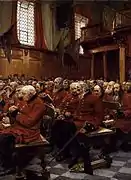 The Last Muster (1875)
The Last Muster (1875)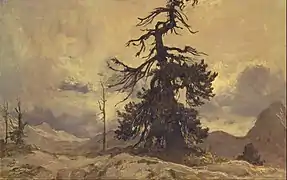 The Dying Monarch, Funtensee, 1884
The Dying Monarch, Funtensee, 1884 Portrait of Henry Hobson Richardson (1886)
Portrait of Henry Hobson Richardson (1886)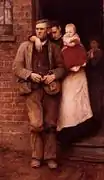 On Strike (circa 1891)
On Strike (circa 1891) Poster for the rally initiated by Herkomer (1907).
Poster for the rally initiated by Herkomer (1907).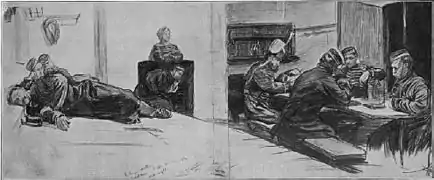 A Guard-Room at Aldershot (1870)
A Guard-Room at Aldershot (1870).jpg.webp) Sunday at the Chelsea Hospital (1871).
Sunday at the Chelsea Hospital (1871)..jpg.webp) The 'Schuhplattl' Dance (1873)
The 'Schuhplattl' Dance (1873)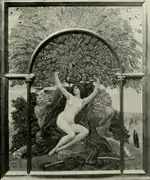 Beauty's Altar, 1900
Beauty's Altar, 1900
Writings
- Art Tuition, (Peacock, Printer, 1882; p19) - lecture in Birmingham Town Hall, on February 10, 1882.
- The Pictorial Music Play. (Magazine of Art, July 1889, pp. 316–24).[8]
- Scenic Art. (Magazine of Art, July 1889, pp. 316–24).[8]
- Autobiography of Hubert Herkomer (Printed for private circulation, 1890, p71).
- Etching and Mezzotint Engraving (London: Macmillan, 1892, p107).
- A new Black and White Art, 1896, p58.
- A certain phase of lithography (London: Macmillan, 1910, p38) - a lecture in Lululaund, for invited guests, on January 27, 1910.
- My School and my Gospel (London : A. Constable and Co. Ltd., 1908).[9]
- The Herkomers. Vol. 1. (London: Macmillan, 1910).
- The Herkomers. Vol. 2. (London: Macmillan, 1911).[9]
References
- Chums annual, 1896, p. 279
- "Oxford Art Society get ready to showcase local talent". LivinginOxford.com. Retrieved 18 October 2020.
- Morgan, Sion (4 August 2014). "Archdruid calls for peace in 'Wales, Europe and the entire world' at National Eisteddfod". Walesonline.co.uk. Retrieved 29 January 2018.
- "Archived copy". Archived from the original on 2016-03-07. Retrieved 2016-03-07.CS1 maint: archived copy as title (link)
- Hubert von Herkomer, BBC, accessed August 2011
- "Watercolors on Ivory by Cecil Jay (Mrs. George Hitchcock) – Indianapolis Museum of Art". Imamuseum.org. Retrieved 1 March 2016.
- "Bushey Artists". Bushey Museum & Art Gallery.
- Quoted by Uta Grund, Zwischen den Künsten (Revised thesis, doctoral, Berlin 1999, p243.
- Note: PDF-versions are facsimiles and are complete. So-called "Full Text" (*.txt)-Versions from same sources are not, missing dozens of pages, as of 20090214.
Further reading
- Baldry, A. L. Hubert von Herkomer, R.A., a Study and a Biography (London: G. Bell, 1901).
- Courtney, W. L. Professor Hubert Herkomer, Royal Academician, His Life and Work, (London, Art journal Office, 1892).
- Bucknole, Mike W. Southampton School and College of Art: a celebration of 150 years of artistic success, Southampton Solent University (2005).
- Bucknole, Mike W. Sir Hubert von Herkomer, CVO, RA (1849-1914), His Southampton life and early influences The British Art Journal, Volume VII, No.1 (Spring/Summer 2006), pp. 72–79.
- Bucknole, Mike W. All Roads Lead to London…or elsewhere: the Southampton School of Art, 1855-1984 Miles Taylor (ed.) SOUTHAMPTON Gateway To The British Empire, I.B. Tauris (London 2007), pp. 48–64.
- Bucknole, Mike W., Hubert Herkomers' Roses - A journey of discovery to investigate provenance (New York 2008), My Publisher. Com.
- Fenwick, Simon, 'Herkomer v Waterlow: The Presidential Election of the Royal Society of Painters in Watercolours', The British Art Journal, Volume III, No.3, Autumn 2002, pp. 48–51.
External links
| Wikimedia Commons has media related to Hubert von Herkomer. |
- 207 paintings by or after Hubert von Herkomer at the Art UK site
- Bushey Museum and their Herkomer collection
- Herkomer biographical information
- Phryne's list of paintings by Herkomer in accessible collections in the UK
- Descriptive catalogue of portraits, etchings and engravings by Hubert von Herkomer
- Sir Hubert von Herkomer at Library of Congress Authorities, with 17 catalogue records